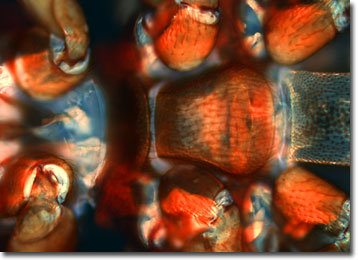Fluorescence Digital Image Gallery
Bed Bugs (Cimex lectularius)
Cimex lectularius is an insect commonly referred to as the bed bug that belongs to the true bug order Hemiptera. The flat, oval-shaped, reddish-brown insect is about 1/5 inch long and 1/8 inch wide, although the body transforms into an elongated blood-filled tube after a three to ten minute feeding on a warm-blooded animal's blood.

Bed bugs have an elongated proboscis, or beak, which is a special mouthpart enabling the insect to break skin very easily. When it isn't feeding, the proboscis rests under the body. When it's needed, it extends and thrust into the victims' skin to retrieve blood nutrients.
Bed bugs feed primarily on human blood, but can be found on bats, rabbits, domestic animals, and other warm-blooded mammals. They also have the ability to survive long periods of starvation and adverse temperatures. Bed bugs are mentioned in early European history and literature and are believed to have been transported around the world by clothing and bedding. Today, they are found in both temperate and tropical regions. These bugs have the potential to carry diseases, but there is not any evidence that they have ever transmitted disease. Some people are not affected by bed bug bites, but others can have an allergic reaction to the bug's saliva resulting in uncomfortable itching and red welts. Dried blood, fecal spots, and a sweet odor may indicate bed bug infestations.
Reproduction is an important part of the lives of bed bugs. To fertilize a female, the male punctures her body wall in order to inject sperm into her abdomen. The female then lays approximately 200 eggs, usually at the rate of three or four a day. She lays these eggs in or near her resting-place, and the eggs will hatch a week or two later and will live for about four months. The nymphs molt five times before becoming adults, which takes about four to nine weeks. Blood meals are necessary during each stage of growth. So sleep tight and don't let the bed bugs bite.
The specimen presented here was imaged with a Nikon Eclipse E600 microscope operating with fluorite and/or apochromatic objectives and vertical illuminator equipped with a mercury arc lamp. Specimens were illuminated through Nikon dichromatic filter blocks containing interference filters and a dichroic mirror and imaged with standard epi-fluorescence techniques. Specific filters for the bed bug specimen were a UV-2E/C, B-2E/C, and a Y-2E/C. Photomicrographs were captured with an Optronics MagnaFire digital camera system coupled to the microscope with a lens-free C-mount adapter.
BACK TO THE FLUORESCENCE DIGITAL IMAGE GALLERY
